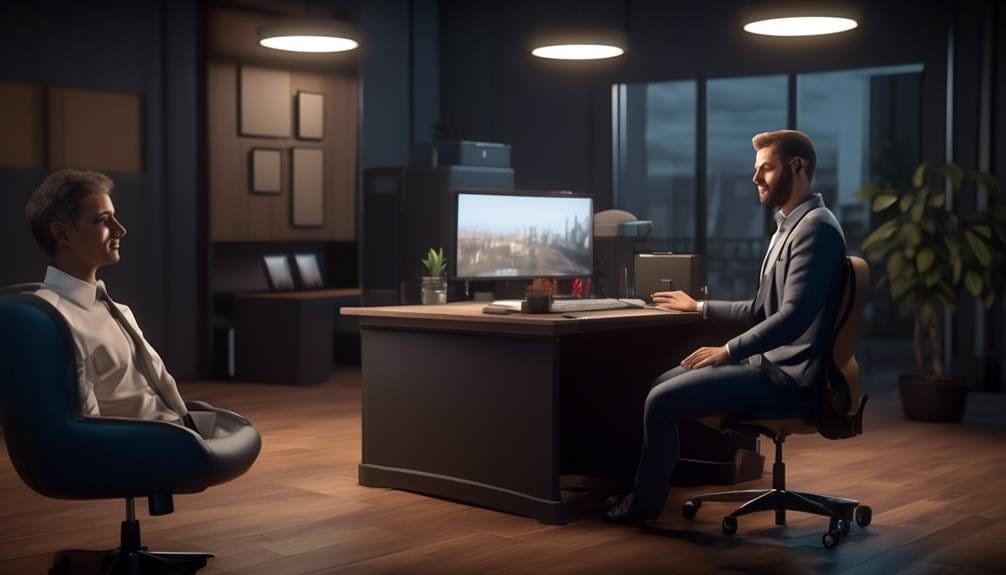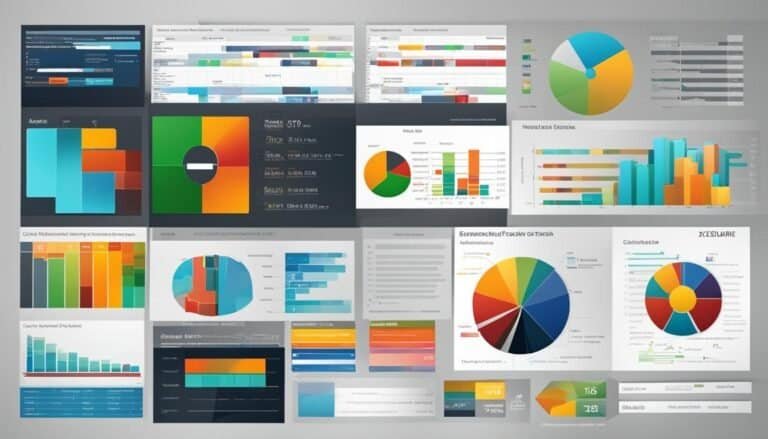The Do's and Don'ts of Virtual Interviews in the Modern Workplace
In today's rapidly evolving professional landscape, virtual interviews have become an integral part of the hiring process. As we navigate through the nuances of remote work, mastering the art of virtual interviews is crucial for both job seekers and employers.
From the initial technological setup to the intricacies of non-verbal communication, there are numerous factors to consider. Understanding the do's and don'ts of virtual interviews can significantly impact one's success in securing a position or identifying the right candidate.
Let's explore the essential guidelines that can make or break a virtual interview experience in the modern workplace.
Key Takeaways
- Thoroughly check your equipment, including camera, microphone, and internet connection, before the virtual interview.
- Dress professionally from head to toe, paying attention to grooming and personal hygiene.
- Create a quiet, well-lit space for the interview and ensure your background is tidy and professional.
- Communicate effectively during the interview by actively listening, paying attention to nonverbal cues, and providing concise and focused responses.
Preparing Your Technology
Ensuring that your technology, including hardware and software, is properly set up and functioning smoothly is crucial for a successful virtual interview experience.
Before the interview, conduct a thorough check of your equipment. Test your camera, microphone, and internet connection to ensure they are all working optimally. Troubleshooting technology issues beforehand can help prevent any disruptions during the interview.
It's also important to familiarize yourself with the virtual interview platform that will be used. Whether it's Zoom, Skype, or another software, make sure you have it installed, updated, and tested for functionality.
Additionally, pay attention to your surroundings. Choose a quiet, well-lit space for the interview and inform household members to minimize interruptions.
When setting up for a virtual interview, consider your appearance on camera. Dress professionally and maintain good posture to convey a positive impression.
Furthermore, have any relevant documents or notes organized and readily accessible on your computer desktop.
Dressing Appropriately
Proper attire for a virtual interview is essential in presenting a polished and professional image. When choosing appropriate clothing for a virtual interview, it's important to consider virtual interview etiquette to ensure you make a positive impression. Here are some key points to keep in mind:
- Dress professionally from head to toe, even though the interviewer may only see the top half of your body. This will help you feel more confident and maintain a professional demeanor throughout the interview.
- Opt for solid colors or subtle patterns as they appear more polished on camera. Avoid overly bright or distracting patterns that may draw attention away from what you are saying.
- Pay attention to grooming and personal hygiene. Your overall appearance should reflect that of someone who takes the interview process seriously.
- Consider the company culture when choosing your outfit. Research the company's dress code and try to align your attire with their expectations, whether it's formal business attire or a more casual look.
Setting the Right Environment
How can you create a professional and conducive environment for a virtual interview that aligns with the expectations of the modern workplace?
Creating a suitable space for a virtual interview is crucial for leaving a positive impression on your potential employer. Select a quiet, well-lit area in your home, free from potential interruptions. Ensure that the background is tidy and professional, free from any clutter or distracting elements. A plain wall or a neatly arranged bookshelf can serve as suitable backdrops.
Additionally, maintaining decorum during the virtual interview is essential. Dress professionally and avoid any casual attire. It is also important to minimize any potential disruptions during the interview. Inform your household members about the interview time to avoid any unexpected disturbances.
Furthermore, test your equipment beforehand to ensure a smooth and uninterrupted virtual interview experience.
Communicating Effectively
Creating a professional and conducive environment for a virtual interview, as discussed in the previous subtopic, is essential for leaving a positive impression on potential employers. However, effective communication is equally crucial in showcasing your qualifications and suitability for the role. Here are some key strategies for communicating effectively during a virtual interview:
- Active Listening: Demonstrate your attentiveness by actively listening to the interviewer's questions and comments. Avoid interrupting and ensure that your responses address the specific points raised.
- Nonverbal Cues: Pay attention to your nonverbal cues, such as maintaining eye contact, nodding, and using appropriate facial expressions. These cues can convey engagement and interest in the conversation.
- Clear Articulation: Speak clearly and enunciate your words to ensure that your responses are easily understandable. Avoid speaking too quickly or mumbling, as this can hinder effective communication.
- Concise Responses: Provide concise and focused responses to the interviewer's questions. Avoid rambling or providing excessive detail, and strive to convey your points in a clear and organized manner.
Showcasing Professionalism
To showcase professionalism in virtual interviews, it is important to pay attention to attire and background. Dressing appropriately and ensuring a tidy, professional background can significantly impact the impression you make.
Additionally, maintaining communication etiquette by being punctual, using professional language, and expressing gratitude can further demonstrate professionalism in virtual interviews.
Attire and Background
Ensuring a professional attire and background during virtual interviews is essential for making a positive impression on potential employers. Paying attention to these details demonstrates your professionalism and respect for the opportunity. Here are some key points to consider:
- Attire: Dress as you would for an in-person interview, opting for professional attire that reflects the company's dress code.
- Background Decor: Choose a tidy, clutter-free background with neutral or professional decor. It should not distract from the focus on you.
- Lighting and Sound: Ensure good lighting and minimal background noise for clear visibility and audibility.
- Virtual Handshake: Greet the interviewer with a confident and professional virtual handshake at the beginning and end of the interview, mirroring the gesture in person.
Communication Etiquette
Exhibiting polished communication etiquette during virtual interviews is paramount for conveying professionalism and fostering a positive impression with potential employers. Two essential aspects of communication etiquette in virtual interviews are nonverbal cues and active listening. Nonverbal cues, such as maintaining eye contact, nodding, and smiling, can convey engagement and interest in the conversation. Additionally, active listening, which involves paying full attention to the speaker, interpreting their message, and providing appropriate feedback, is crucial for demonstrating respect and understanding. To further illustrate the significance of these elements, the table below outlines their importance in virtual interviews.
| Communication Etiquette in Virtual Interviews | |
|---|---|
| Nonverbal Cues | Active Listening |
| Eye contact | Focus on the speaker |
| Facial expressions | Avoid interrupting |
| Body language | Provide verbal and nonverbal feedback |
Managing Distractions
When participating in virtual interviews, managing distractions is crucial for maintaining a professional image. This involves controlling background noise to ensure clear communication and maintaining focus on the camera to convey attentiveness.
Addressing these points will help candidates create a distraction-free environment and present themselves in the best possible light during virtual interviews.
Noise Control
Minimizing background noise and managing distractions is essential for maintaining a professional and focused atmosphere during virtual interviews in the modern workplace. To ensure a distraction-free environment and effective non-verbal communication, consider the following:
- Soundproofing solutions: Invest in noise-canceling headphones or consider using soundproofing materials in your workspace to minimize external disturbances.
- Virtual etiquette: Remind household members to keep noise levels to a minimum and to avoid interrupting during the interview.
- Background noise: Select a quiet location for the interview and close windows to reduce outdoor noise.
- Non-verbal communication: Pay attention to your body language and facial expressions, as they can convey professionalism and attentiveness despite potential distractions.
Focus on Camera
To maintain a professional and focused atmosphere during virtual interviews, it is imperative to shift the focus from noise control to managing distractions through effective camera management.
Improving lighting is crucial to ensure that the interviewer can clearly see the candidate's facial expressions and body language. Natural light or a well-positioned lamp can significantly enhance visibility and create a more engaging presence.
Additionally, candidates should position their camera at eye level and maintain good posture to project confidence and attentiveness. A clutter-free and neutral background can also help minimize distractions and keep the focus on the candidate.
Engaging body language, such as nodding and smiling, can further convey interest and enthusiasm.
Researching the Company
It is essential to thoroughly research the company before a virtual interview in order to demonstrate a strong understanding of its values, mission, and current projects. This preparation allows candidates to align their responses with the company's culture and values, showing the interviewer their genuine interest in the organization.
When researching the company, consider the following:
- Company Culture: Understand the company's working environment, values, and employee relations. This will help you gauge if the company is a good fit for you and tailor your responses to align with their culture.
- Industry Trends: Stay informed about the latest trends and developments in the industry. Being knowledgeable about the industry will demonstrate your proactive approach and genuine interest in the field.
- Interviewer Expectations: Anticipate the interviewer's expectations by researching their background and role within the company. Tailoring your responses to their expectations can leave a positive impression.
- Company Values: Familiarize yourself with the company's mission, vision, and values. Show how your own values align with those of the company, demonstrating your potential contribution to their objectives.
Thorough research into the company will empower candidates to showcase their understanding of the organization and make a compelling case for their candidacy.
Asking Thoughtful Questions
When concluding a virtual interview, it is imperative for candidates to ask thoughtful questions that demonstrate their engagement and understanding of the company and role. Engaging in a conversation with the interviewer and asking insightful questions not only showcases your active listening skills but also allows you to gain a deeper understanding of the company's culture, expectations, and the role itself.
Thoughtful questions can revolve around the company's future plans, challenges it may be facing, and how the role you are applying for fits into the larger organizational structure. Additionally, you can inquire about the team dynamics, opportunities for growth and development, and the company's approach to remote work, if applicable.
Following Up Post-Interview
After a virtual interview, it is essential to send a well-crafted follow-up message to express gratitude for the opportunity and reaffirm your interest in the position. This not only demonstrates your professionalism but also keeps you fresh in the interviewer's mind.
Here are some key points to consider when sending a follow-up message:
- Express Gratitude: Begin your message by expressing your gratitude for the opportunity to interview for the position. Thank the interviewer for their time and for considering you as a candidate.
- Reiterate Interest: Reaffirm your interest in the position and the company. Highlight specific aspects of the role or the organization that excite you and align with your career goals.
- Address Any Pending Items: If there were any questions or topics discussed during the interview that you need to clarify or elaborate on, use the follow-up message to provide additional information or insights.
- Inquire About Next Steps: Politely inquire about the timeline for the hiring process and ask about the next steps. This demonstrates your eagerness and proactive approach towards the opportunity.
Sending a well-crafted follow-up message will leave a positive impression and potentially influence the interviewer's decision-making process.
Avoiding Common Mistakes
To enhance the effectiveness of your follow-up message after a virtual interview, it is crucial to be mindful of common mistakes that could detract from the professionalism and impact of your communication.
One of the common pitfalls to avoid is sending a generic follow-up message. Tailoring your message to reflect specific points of discussion during the interview and reiterating your interest in the role demonstrates your attention to detail and genuine enthusiasm.
Additionally, failing to proofread your follow-up email can lead to grammatical errors or typos, which may reflect poorly on your attention to detail and communication skills.
Another mistake to avoid is being overly persistent in your follow-up. While it's important to express your continued interest in the position, bombarding the interviewer with multiple follow-up messages can be viewed as pushy and unprofessional.
Lastly, neglecting to send a thank-you note can be a missed opportunity to express gratitude for the interviewer's time and reiterate your interest in the role.
Conclusion
In conclusion, virtual interviews in the modern workplace require careful preparation and attention to detail.
Just as one would dress and prepare for an in-person interview, the same level of effort and professionalism should be applied to virtual interviews.
By following the do's and don'ts outlined in this article, individuals can ensure that they present themselves in the best possible light and increase their chances of success in the virtual interview process.







